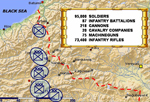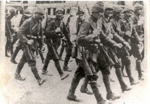Status of the Turkish Army

Sketch: Status of Turkish side
The 3rd Army under the command of Hasan Izzet Pasha was dispersed before the operations. All units were spread out within a range of 1250-1500 kilometers between Elaziğ - Muş - Van - Erzurum. All these units were ordered to deploy to the front immediately. 10th Corps, for instance, was in Sivas-Amasya and Samsun Region and had no preparations at all. Just as in the case of entering into war, the deployment order had created a big shock as well. Of course, the deployment started as required by the order.
In his diary Dr. Derviş Kuntman wrote the following; “We were walking under very tough conditions. Fortunately, the weather was good but we had to walk from Samsun to Erzurum, a large distance about half of the Northern Anatolia. We would pass through Niksar, Kelkit valley, Refahiye and Erzincan. But, we all walked continuously with our bodies as hard as steel. Villagers that we met on the way showed great concern for us. These moderate or poor people’s hospitality was so plain and in such a familiar manner that one can promptly understand that this character was inherited to themselves by their ancestors. These dignified people showed great respect and tenderness to us who were going to war as if we were their true brothers. After their kind hospitality, they followed us for a long distance and the women saw us off crying silently at the doors. This continued all the way towards Erzurum. This was a compulsory debt to be paid to the country by a valor nation accustomed to bring up armies for the fronts for many centuries.’’

Sketch: Status of Turkish side
In short, Corps, Divisions, Regiments and Battalions were all walking with the help of the villagers towards the front willingly.
At last, the deployments were completed. Now, the position of the 3rd Army was as depicted on the screen:
11th Corps in the Aras Valley and its north (Commander Galip Pasha)
— 18th Division
— 33rd Division
— 34th Division
2. 10th Corps in the Tortum Region (Commander Colonel Hafız Hakkı)
— 30th Division
— 31st Division
— 32nd Division
3. 9th Corps in Koşa Region between these two Corps (Commander İhsan Sökmen Pasha)
— 17th Division
— 28th Division
— 29th Division
4. 2nd Cavalry Division in the south of Aras Valley (Commander Lietunant Colonel Yusuf İzzet)
5. Stange Bey detachment
Bahaettin Sakir Bey Guerrillas in Artvin
3rd Army was totaly 134.000 soldiers;
— 87 Infantry Battalions
— 218 Cannons
— 20 Cavalary Companies
Equipment, weapons and logistic support:
The mobilization was completed only on paper and the Turkish Units were in general very tired because of the long distances they covered on foot. It is generally considered that the strength of a Turkish infantry battalions were significantly lower than the strength of their Russian counterparts in number of men.

Photo: The equipment was not compatible with the winter conditions.
The number of officers and non-comission offiers (NCO) was not sufficient. Additionally, the training level of the reserve officers was insufficient. Even the losses of the Balkan war could not be recovered yet. The equipment was not compatible with the winter conditions. Most of the winter equipment of the army had already gone into the depths of the BlackSea when Russians sank the ship called Mitad Pasha. Most of the soldiers were wearing summer clothes. On their feet were the leggings between the knee and the ankle and sandals.
On the other hand, Enver Pasha trusted these soldiers and issued the following declaration on April the 3rd;
“Soldiers, I visited all of you and I saw that you didn’t even have an overcoat and a pair of shoes. But, we will encircle the Russians and conquer the Caucasus where you will find everything you need.”
In short, a great self-sacrifice was being expected from the Turkish Soldiers. Furthermore, the required equipment was being obtained from other units during the inspections and the units were being presented to the commanders as if they were without any shortage. Hence, units avoided successfully the inspections and the commanders were, in a way, deceived. As for the logistic support, 88,000 tons of grain was required, considering the amount of personnel and animals in the army. However, there was only 1,250 tons of grain available. The difference was huge. Due to lack of sufficient logistic support soldiers were subjected to eat dough.
Number of Guns were;
— 73.400 Infantry Rifles
— 75 Machine Guns
— 218 Cannons

Photo: Ottoman P.O.W soldiers (Southern Front)
|